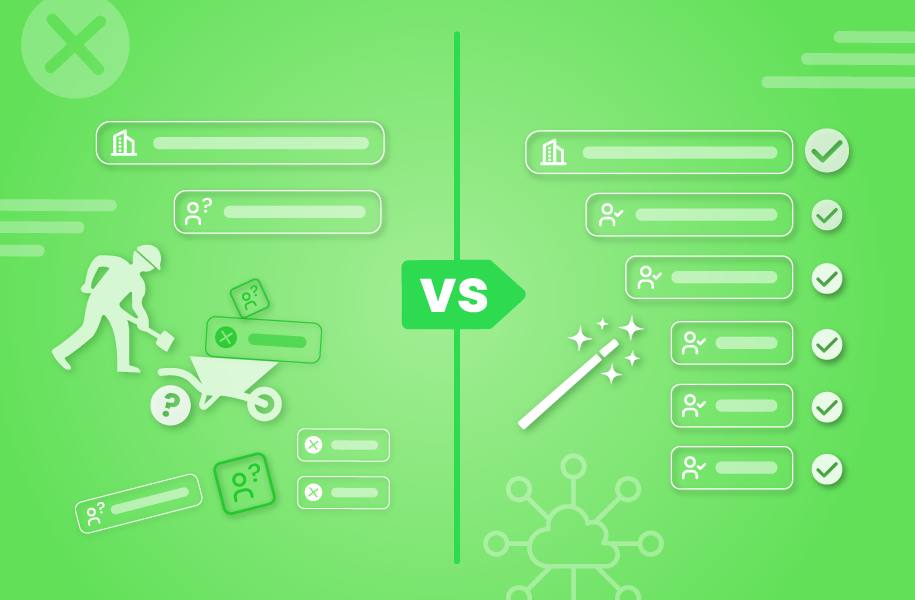Have you ever wondered what other revenue leaders are thinking and doing when it comes to their data challenges?
Whether it’s knowledge, strategy, or a secret stack of tech tools, let’s dive into how do they stay ahead and prevent common data pitfalls from holding their company back.
What are some best practices when it comes to Salesforce Data Governance?
I don’t let an account be created without a country value. Every Salesforce Org I’ve ever been in, by day two, I’m turning on State and Country picklists.
Brooke Treseder, Senior Vice President of Revenue Operations at Checkout.com
To me, it’s the difference between having a clean data set and not. The longer you wait, the dirtier the data gets and then you have to clean it up later.
Brooke places an incredible amount of importance on being able to consistently manage and govern data.
And it’s no surprise. Revenue teams that don’t have clean data are constantly playing from behind.
Turning on State and Country picklists helps create a clean data set where country values are standardized. Teams can then use that data to create formulas or different regions.
Here are some other pro tips and tricks around data governance from Brooke:
- Avoid mass imports that can turn clean data into dirty data
- Implement validation rules like country or website values to help prevent duplicate accounts
Data changes constantly. What’s one way you prevent proliferation in your Salesforce org?
Identify all data entry points and lock them down. Really control how data comes into your organization and have a consistent way in which you’re going to allow people to enter information.
Sean Crowley, Vice President of Marketing at Dun & Bradstreet
I think that if you’re simply allowing your account reps to enter new accounts on their own, that’s a recipe for disaster. You need to have a consistent way in which there’s a matching mechanism so you can avoid duplication and proliferation of poor data.
A starting point for stopping the proliferation and spread of dirty data is controlling how it enters your Salesforce org. If there’s no consistency around how data is entered or new accounts are created, companies will suffer from a lack of information and duplicate accounts.
In fact, Salesforce users and a lack of process is one of the major sources that duplicate data stems from.
Sean’s tip:
- Use a “Search before Create” process to ensures duplicate account doesn’t already exist in the system
- Have a “matching mechanism” or an automated lead-to-account match solution
Having a tool that automates lead to account matching in Salesforce helps remove the manually effort by matching, merging, and converting duplicate records upon entry.
How do you ensure your team is working with both clean and accurate data?
I would say the number one mistake people make is to assume that your sales team and other people are going to keep this really clean, maintained database.
Rusty Jensen, Head of Global ISR Sales at Conga
Really what you should be doing is relying on an external data source that’s already professionally maintained.
Only two in 10 companies strongly agree that their CRM has clean and actionable account data to sell effectively. So what’s one way that Rusty ensures that his team’s data is not just clean but accurate, too?
By creating a strong foundation with external tools that are consistently maintained and up-to-date.
Rusty’s tip:
- Use a third-party data provider that can assist in the enrichment and management of global data
Whether it’s due to accelerated growth, people changing roles, or mergers and acquisitions, companies are changing faster than ever and you need to keep up.
In fact, Rusty even argues that it’s time consuming and even unreasonable to rely on a sales organization to maintain accurate hierarchies and accurate data.
What is the downstream effect of bad data, and how do you tackle this?
Bad data is the source of account conflicts. The biggest piece of advice I’ve got is to get your data in place before your planning seasons. Catching up on all this after you’ve pushed your territories out or after you’ve done your restructuring creates so many issues.
Matt Wester, Sales Planning Manager at Copado
Even before there’s an Opp created, there’s so much time spent planning out these account strategies, getting your contacts, loading them in, and working with marketing. Get this done before your fiscal.
Dirty data is the biggest culprit behind account conflicts and territory disputes. And when your sales team is spending the majority of time resolving a conflict, both company morale and revenue are taking major blows.
Matt’s tip:
- Clean your database and align it with your go-to-market strategy before planning season
Once your data is clean, only then is it time to plan out territories — and using account hierarchies is a great way to optimize that process.
For example, it’s important to identify the subsidiaries of enterprise accounts and where they fall within a hierarchy. When it comes to planning, having this level of information is crucial for scoring or balancing territories.
Data Strategy is What Separates the Leaders from the Scramblers
Top RevOps leaders don’t wait until planning season to fix bad data — they build safeguards into their day-to-day. From strict validation rules to automated lead-to-account matching, their teams operate on clean, connected, and context-rich data.
If you’re still relying on manual checks, delayed lead assignments, or dirty CRM records, it’s time to take the next step. Download our guide to learn how to deduplicate your CRM and set the foundation for scalable growth.




